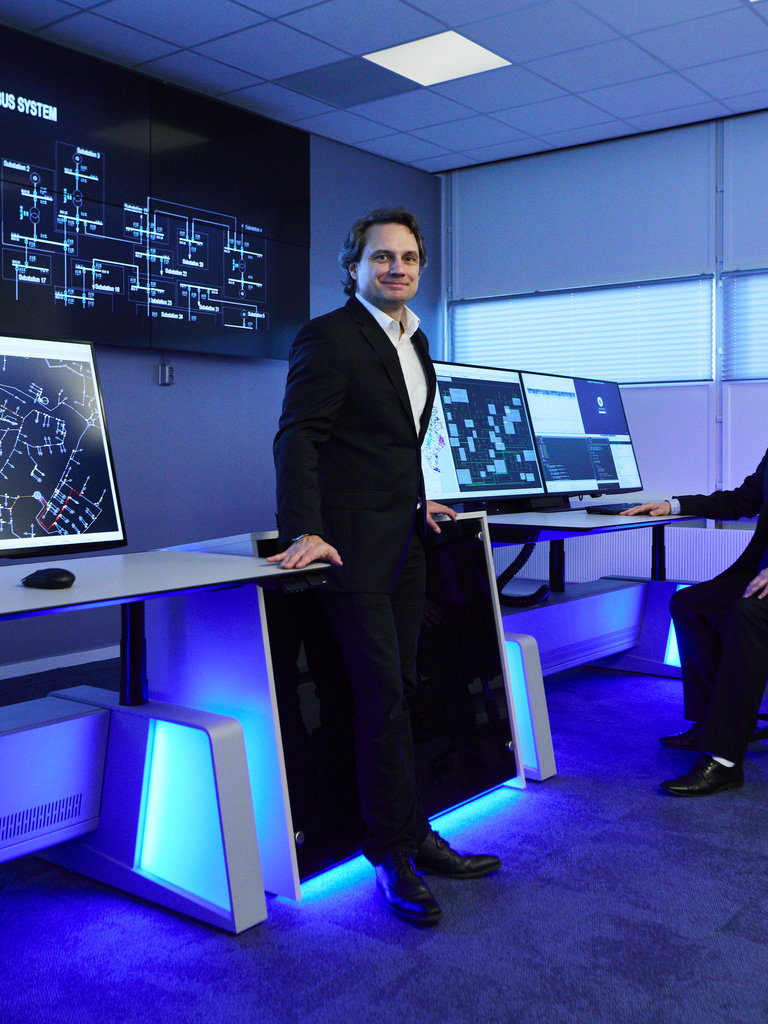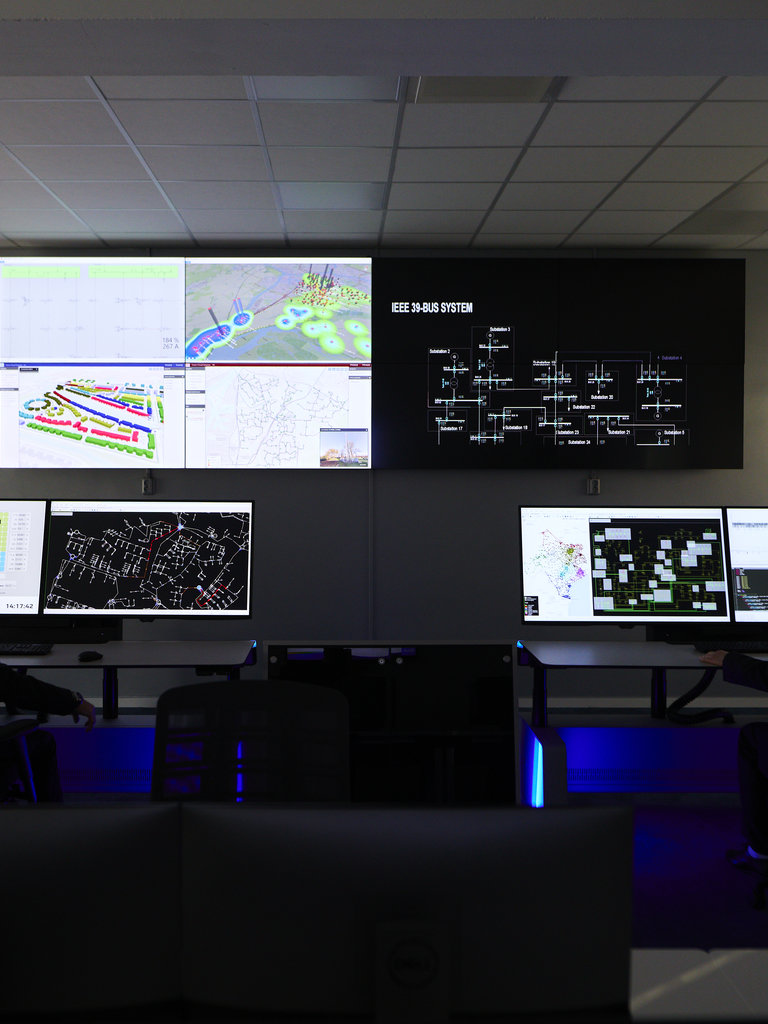
By: Bennie Mols
On 1 October, the Control Room of the Future was opened in TU Delft’s Electrical Sustainable Power Lab. This ultramodern control room can simulate any disruption to the power grid in a controlled research environment, from lightning strikes to cyberattacks.
In the Control Room of the Future, simulating a cyberattack on the power grid is a piece of cake. “We will show you how we research cybersecurity”, says Alex Stefanov, assistant professor in Intelligent Electrical Power Grids at TU Delft's Faculty of Electrical Engineering, Mathematics and Computer Science.
One of his PhD candidates changes ‘false’ to ‘true’ somewhere in the computer code. “Several circuit breakers in the network are now being tripped”, says Stefanov. On a large screen, which depicts the main power lines of the power grid, it now starts happening at breakneck speed. First, one of the main power lines fails. An alarm starts to ring. Then another main line drops out. It is followed by a domino effect as multiple lines fail. All the alarms sounding off simultaneously create an infernal noise. Much of the electricity grid is now down. Fortunately, this catastrophe is only happening in the virtual world.
Many scenarios
It is just one of many possible scenarios being investigated in the Control Room of the Future. “Hacking a power plant is difficult”, says Peter Palensky, professor of Intelligent Electrical Power Grids, “but hacking thousands of electric cars connected to the electricity grid is much easier. We’d better assume that the power grid is going to be hacked and work out how we can detect and curtail cyberattacks and how we can resolve the potential consequences. The idea of perfect protection is illusory.” Palensky leads around ten researchers who are working with the Control Room of the Future.
In reality, cyberattacks are constantly happening on electricity networks across the world. Most of them are nipped in the bud and never make it onto the news. Occasionally, however, things really go wrong. In 2016, for example, cyberattacks on grid operators in Ukraine caused power outages. But the TU Delft researchers are not only focusing on the consequences of cyberattacks on the power grid, but on all kinds of disruptions: from broken transmission lines to short circuits.
“I’m fascinated by how the digital and physical worlds are coming together in control over the power grid”, says Stefanov. “They are two very different worlds and bringing them together hugely increases the complexity of everything that can happen.” Stefanov is the technical director of the control room and also designed the research facility. “The fact that we can simulate the entire ecosystem of electricity generation, transmission, distribution and consumption is quite unique”, he says. “Our control room is an innovation centre where industry and the academic world can meet.” Students and PhD candidates can experiment there, operators of the real, physical electricity network come to share their knowledge and acquire new knowledge and grid operators such as TenneT, distributors like Alliander and Stedin, and vendors like Siemens and General Electric are eager to do research with TU Delft.

Digital twin
Of course, experimenting on the real power grid is out of the question. That’s why experimenting with a digital twin that resembles the real network as far as possible provides a solution. But it does not stop at just one digital twin, explains Palensky: “We’re actually using a whole family of simulations, not just a twin, but also brothers, sisters, nephews and nieces, all with their own characteristics. The power grid is so complex that we have to run lots of different simulations to explore everything that might happen when there are disruptions.”
The application of artificial intelligence (AI) is set to play an important role in the Control Room of the Future. “We’ll be using AI to detect cyberattacks, develop defence strategies and to support the human operators working in the real control rooms”, says Stefanov. “Currently, people are always involved in the process of monitoring the power grid. They keep an eye on electrical capacity and voltages and ensure that the electricity supply is effectively coordinated to meet demand. In the future, AI could take on some of the human tasks involved. We might see something similar to what happens in aircrafts, where the human pilots usually do the take-off and landing, but the automatic pilot takes care of the most predictable part of the flight.”
“Ideally, the human operators should be able to learn from the AI”, adds Palensky, “and the AI learn from the human operators. Just like in an aircraft, totally replacing humans is something far off in the future.” Besides this, human operators struggle to accept AI decisions if it is unclear why the intelligent system is suggesting them. “That shows that we need to work on explainable decisions”, continues Palensky, a key research theme across the whole field of artificial intelligence.
Virtual reality
What do Palensky and Stefanov expect the Control Room of the Future to look like in five or ten years’ time? “By then, we have a digital twin of the whole Dutch electricity network”, says Palensky. “And perhaps also one that we can connect to twins of other European countries. I also anticipate human operators doing their work wearing virtual-reality headsets. And it’s almost certain that AI will take on some of the tasks that people are currently doing.”
The Control Room of the Future is like a breeding ground for the power grid of the future. There is no doubt that it will need breakthroughs in network management, flexible topologies, and the algorithms that monitor and control the electricity network. “We envisage a future in which the operation of the power grid is autonomous, intelligent, resilient, and cyber secure”, concludes Stefanov.
Energy transition
The idea for the Control Room of the Future was partly inspired by the energy transition, which is also the driving force behind much of the research happening in the overarching Electrical Sustainable Power Lab. Palensky: “In an attempt to move away from fossil fuels, society is in the process of transitioning anything still running on oil and gas to electricity: industry, the transport sector and the way we heat our homes. As a result, demand for electricity will majorly increase in the future.”
The energy transition is also changing the nature of the power grid: from a centralised network with several large power plants, to a decentralised network with relatively small-scale energy generators, such as solar panels and wind turbines, distributed widely. This transition leads to new challenges on how the power grid is managed.
Palensky and Stefanov hope that the Control Room of the Future will help accelerate the energy transition. “The fact that various major companies from the electricity sector are working with us means that we can quickly transfer knowledge”, says Palensky. “Political decision-making is just one aspect involved in achieving the energy transition: the businesses that manage the physical infrastructure also need to be ready for the transition. We’re helping them to find new solutions faster.”